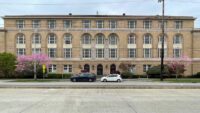
INS Building / Inscape Landmark Nomination
Support Preservation in the C-ID!
Last fall, Historic Seattle submitted a landmark nomination application for the former INS Building (815 Seattle Blvd S.) in Seattle’s Chinatown-International District. On Wednesday, June 5, the Seattle Landmarks Preservation Board (LPB) will consider the nomination for landmark status. If nominated, the Board will hold a designation hearing in July. We encourage you to support our nomination by submitting written comments to City Historic Preservation Officer Sarah Sodt (email to sarah.sodt@seattle.gov) by May 31. You may also provide verbal comments at the LPB meeting on June 5 at 3:30 pm. The meeting is hybrid so you may comment via WebEx and attend the meeting virtually. Learn more about submitting written and verbal comments to the Board here. The agenda will be published about one week before the June 5 meeting.
Short for Immigration & Naturalization Service, the former INS Building (originally known as the U.S. Immigrant and Assay Office) served as Seattle’s detention and processing center for immigrants from 1931 until 2004. In 2008, a group of private investors purchased the building and transformed it into an arts and culture center. Known as Inscape Arts since 2010, this place matters not only for the complex histories it contains but also as an example of how art and community can be the impetus for both recognizing the difficult past and supporting culture and creative space. Historic Seattle’s HeartBomb in February with Friends of Inscape took place in front of the building.
The former INS Building is listed individually in the National Register of Historic Places and Washington Heritage Register and is a contributing resource in the International Special Review District (ISRD). We hope it will soon be a designated Seattle landmark. Learn more about the former INS Building’s history and significance in the nomination report prepared by NW Vernacular. Graphics for the report can be found here.
The former INS Building has a high level of integrity and ability to convey significance, and we believe the property meets four of the six designation standards of the Landmarks Preservation Ordinance (standards A, B, C, and F):
A) It is the location of, or is associated in a significant way with, a historic event with a significant effect upon the community, City, state, or nation; or
[The building is associated with the WWII incarceration of Japanese Americans. After the bombing of Pearl Harbor by Japan on December 7, 1941, the FBI conducted sweeps in Seattle to round up Japanese residents who were then taken to the immigration station. Their personal effects were confiscated and stored at the station. The FBI also arrested and detained U.S. citizens at the immigration station for alleged anti-U.S. acts.]B) It is associated in a significant way with the life of a person important in the history of the City, state, or nation; or
C) It is associated in a significant way with a significant aspect of the cultural, political, or economic heritage of the community, City, state or nation; or
[As the immigration station in Seattle for 73 years, the building is associated in a significant way with the city’s immigration history through most of the twentieth century. This history is a significant aspect of the city’s cultural and political heritage.]D) It embodies the distinctive visible characteristics of an architectural style, or period, or a method of construction; or
[The building was designed in the Mediterranean Revival style and reflects the distinctive characteristics of the style.]
E) It is an outstanding work of a designer or builder; or
F) Because of its prominence of spatial location, contrasts of siting, age, or scale, it is an easily identifiable visual feature of its neighborhood or the city and contributes to the distinctive quality or identity of such neighborhood or the City.
[The building’s scale and massing contrast with surrounding buildings making it an easily identifiable building within the Chinatown-International District neighborhood. The building’s design and original use contribute to the identity and distinctive qualities of the neighborhood.]
INS Holdings (as property owner) has generally been a good steward of the INS Building. Its use as arts and culture space after federal government ownership has been an excellent example of the adaptive reuse of this historic building. Given the individual listing in both the State and National registers, inclusion as a contribution resource in the ISRD, and the protective covenant that came with the sale to INS Holdings when it acquired the property, we believe local landmark designation is an appropriate additional layer of designation and protection for the historic property. The property owner placed the property on the market a couple years ago, but it did not sell. Its future as arts and culture space depends on who owns the property. While landmark designation does not dictate use, we still believe obtaining this status will help preserve the building for the future.
Photo: INS Building/Inscape, 2023 (Eugenia Woo)

